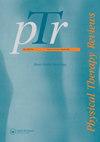疼痛性颞下颌关节紊乱病患者的生活质量:结果测量、临床和预测特性的系统综述
IF 0.8
Q4 REHABILITATION
引用次数: 2
摘要
背景有许多自我报告结局测量(srom)用于测量疼痛性颞下颌疾病(TMD)患者的生活质量(QoL)。然而,目前还不确定哪种只读存储器最适合研究和临床实践。目的是:(1)确定疼痛性TMD患者生活质量的临床可靠的srom;(2)确定生活质量受损是否对该人群具有诊断或预后价值。方法采用PRISMA指南系统检索CINAHL、Dentistry & Oral Science Source、PsychALL、PubMed、Scopus和Web of Science。研究纳入了对成年疼痛性TMD患者进行生活质量评估的研究。对偏倚风险进行了检查。结果共纳入23项研究;8项临床研究主要验证了语言翻译,而其他研究是诊断性的(n = 14)或预后性的(n = 1)。在评估的8个确定的srom中,只有口腔健康影响量表(OHIP)-49、OHIP-TMD (OHIP-22)、OHIP-14和SF-36在疼痛性TMD中是有效和可靠的。在诊断研究中,区域特异性和非区域特异性的生活质量srom都将TMD的存在与生活质量差联系起来。研究异质性禁止meta分析。SF-12展示了预测能力。结论对于区域特异性srom, OHIP-49、-TMD/-22和- 14有多种语言版本可供临床医生使用,用于记录疼痛性TMD患者的生活质量。对于对总体生活质量感兴趣的临床医生来说,SF-36在这一人群中是有效的。新出现的证据表明,基线生活质量可以预测未来的结果。本文章由计算机程序翻译,如有差异,请以英文原文为准。
Quality of life in painful temporomandibular disorders onset: a systematic review of outcome measure clinimetrics and predictive properties
Abstract Background Many self-report outcome measures (SROMs) exist for measuring Quality of Life (QoL) in patients with painful temporomandibular disorders (TMD). However, it is uncertain which SROM(s) is/are best suited for research and clinical practice. Objectives The aims were to (1) identify clinimetrically sound SROMs for QoL in patients with painful TMD and (2) determine if impaired QoL has diagnostic or prognostic value for this population. Methods PRISMA guidelines were utilized during a systematic search of: CINAHL, Dentistry & Oral Science Source, PsychALL, PubMed, Scopus, and Web of Science. Studies involving adult populations with painful TMD who were assessed for QoL were included. Risks of biases were examined. Results 23 studies were included; 8 clinimetric studies primarily validated language translation whereas other studies were diagnostic (n = 14) or prognostic (n = 1). Of the eight identified SROMs assessed, only the Oral Health Impact Profile (OHIP)-49, OHIP-TMD (OHIP-22), OHIP-14, and the SF-36 are valid and reliable in painful TMD. In regards to the diagnostic studies, both region- and non-region-specific QoL SROMs associated presence of TMD with poor QoL. Study heterogeneity prohibited meta-analysis. The SF-12 demonstrated prognostic capabilities. Conclusion For region-specific SROMs, the OHIP-49, -TMD/-22, and −14 are available to clinicians in multiple languages to capture QoL in patients with painful TMD. For clinicians interested in overall QoL, the SF-36 was found to be valid in this population. Emerging evidence has shown that baseline QoL can predict future outcomes.
求助全文
通过发布文献求助,成功后即可免费获取论文全文。
去求助
来源期刊

Physical Therapy Reviews
REHABILITATION-
CiteScore
1.30
自引率
0.00%
发文量
26
期刊介绍:
Physical Therapy Reviews is an international journal which aims to publish contemporary reviews, discussion papers and editorials within physical therapy, and in those basic and clinical sciences which are the basis of physical therapy. The journal is aimed at all those involved in research, teaching and practice within the area of physical therapy. Reviews (both descriptive and systematic) are invited in the following areas, which reflect the breadth and diversity of practice within physical therapy: •neurological rehabilitation •movement and exercise •orthopaedics and rheumatology •manual therapy and massage •sports medicine •measurement •chest physiotherapy •electrotherapeutics •obstetrics and gynaecology •complementary therapies •professional issues •musculoskeletal rehabilitation
 求助内容:
求助内容: 应助结果提醒方式:
应助结果提醒方式:


